Reading Strategies are techniques used to help understand, interpret and appreciate texts.
Choosing the appropriate strategy according to the reading purpose is essential. Each strategy has its own uses, functions and benefits.
Having a clear reading purpose will allow you to choose the most effective strategy for what is needed.
To learn more about a strategy, click its name.
|
Get an overview of the text. |
Quickly search & find information |
Ask yourself questions |
|
Create mental pictures |
Relate to the text |
Read between the lines |
|
Write down notes & comments |
Understand challenging words |
Sum up main idea & key elements |
|
Explore sources to come up with new perspectives |
Form an opinion on the quality of the text |
Look at the structure and techniques used |
Previewing is getting an overview of the text.
When to do it
-
Before reading the text
Reading intention
-
Activate prior knowledge
-
Check if it matches the reading purpose
Outcome
-
Get a general overview of the text—Big picture
-
Give an idea of which strategies to use
How to Do It
Text features can quickly and easily give you a general idea of what the text is about.
Easily recognizable features* are:
-
Text elements
-
Visuals
-
Structure & organization
*Keep in mind that the text features used vary according to the text type and purpose.


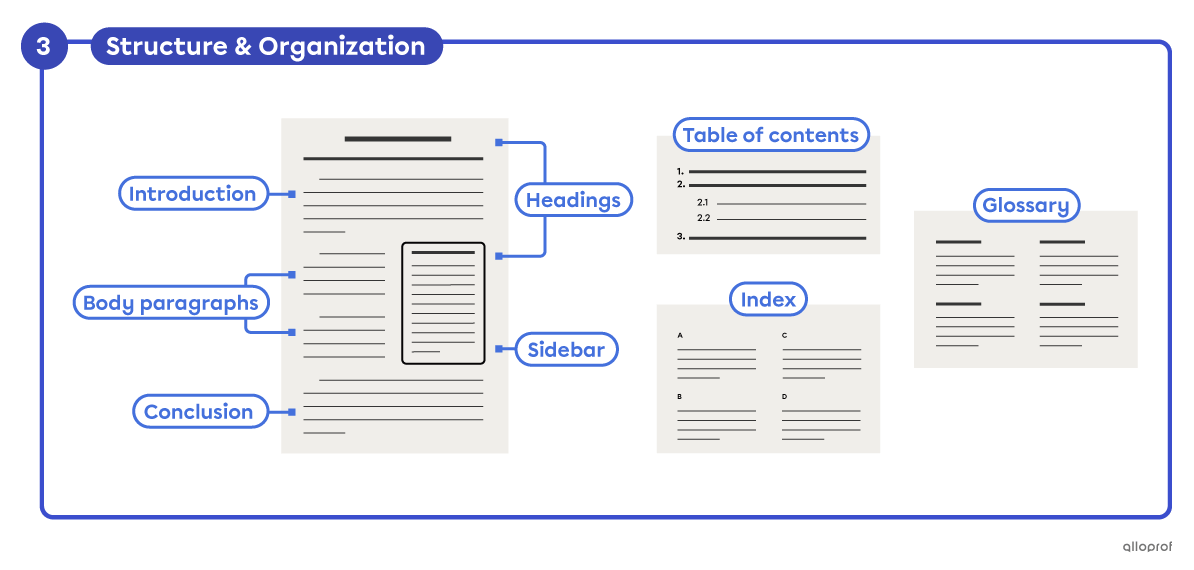
Give some parts of the text a quick read to get an overview of the topic.
The quick read is more relevant when dealing with the format of opinion pieces, argumentative texts, persuasive texts and informational texts.
-
Skim the introduction and the conclusion
The introduction and the conclusion of a text often mention most of the general ideas contained in it.
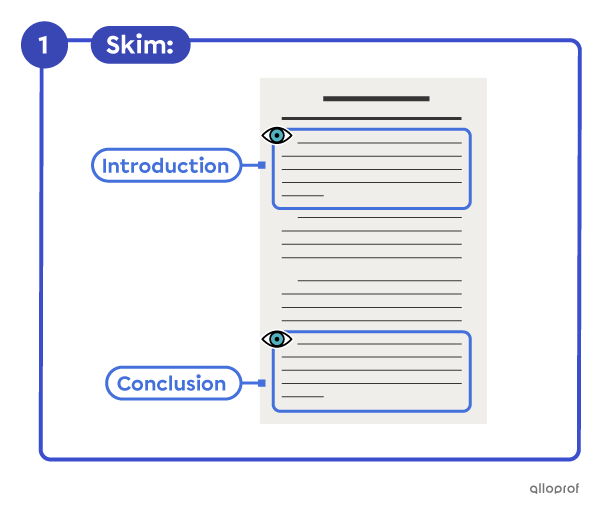
See Skimming for more information.
-
Skim the first sentence of each paragraph
The first sentence of a paragraph often indicates the main topics of a text.
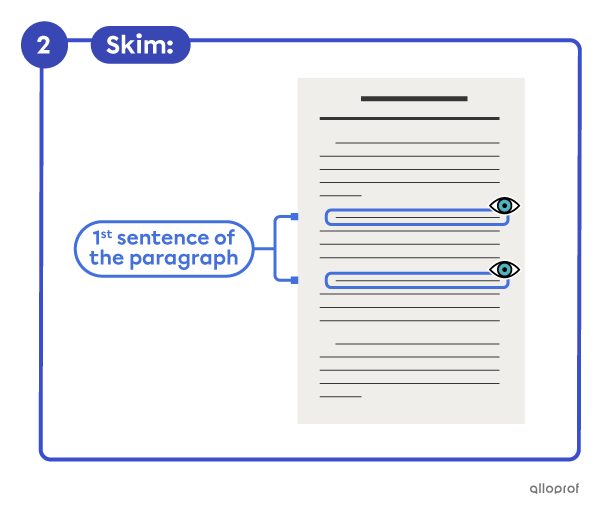
See Skimming for more information.
Activating readies your mind to receive new information and guides your reading focus.
The activating steps are:
-
Think about what you already know on the topic, however much it is. It will provide helpful context information for the text.
-
Make an educated guess on what the topic will be and what you might learn from the text.
-
Set your reading goals.
-
Form questions you think the text will answer.

Skimming and scanning are strategies to find information quickly.
Skimming is giving some parts of a text a quick read.
When to do it
-
Before reading the text
-
While reading the text
-
After reading the text
Reading intention
-
Before: to get a general idea of what the text is about while previewing
-
While: to see what is next
-
After: to refresh your memory by taking a another look at a text you’ve already read
Outcome
-
Get a general overview of the text—Big picture
-
Help make predictions
-
Refresh memory
How to Do It
-
Read titles & headings
-
Look for bold, italicized or highlighted text
-
Quick read of the introduction & conclusion
-
Quick read of the first sentence of paragraphs
Scanning is looking for specific information without reading the whole text.
When to do it
-
Before reading the text
-
While reading the text
-
After reading the text
Reading intention
-
Find specific information quickly
-
Find keywords and repetitions
Outcome
-
Quickly find & gather specific information
How to Do It
-
You must know what you are looking for beforehand
-
Use text features & visual markers
-
Look for keywords
When in doubt about which to use, the rule of thumb is:
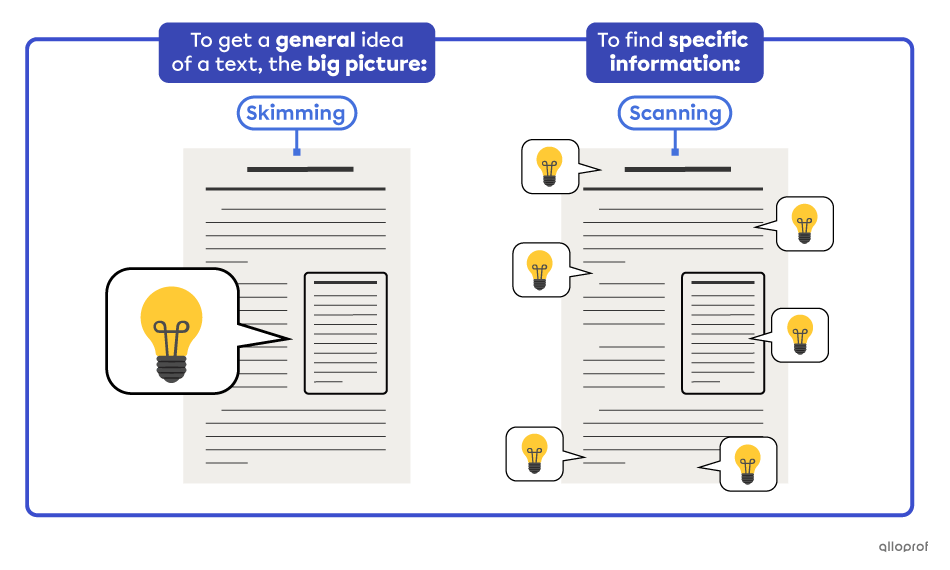
Questioning is asking yourself questions about the text and its meaning.
When to do it
-
Before reading the text
-
While reading the text
-
After reading the text
Reading intention
-
Predict what the text is about
-
Check understanding
-
Reflect on text
-
Analyze text content & structure
-
Make connections
Outcome
-
Activate prior knowledge
-
Get a deeper understanding
-
Validate comprehension
-
Find author’s purpose
Here are some examples of general questions.
|
To ask before reading the text. |
Purpose |
|
Why are you reading this text? |
Reading purpose—The reason for reading the text influences what you get out of the reading experience. |
|
What are the main features? |
Previewing |
|
What type of text is it? |
Text type—The reason for using a specific text type reflects its purpose. |
|
What is the text going to be about? |
Prediction—Making an educated guess after previewing. |
|
Who is the author? |
Prediction—Predicting topics, genres, style, voice, themes… according to known information on the author. |
|
What do you expect to learn from the text? |
Prediction—Expectations according to text type, genre, themes, subject, author’s previous works… |
|
What do you know about this topic? |
Activating prior knowledge—Preparing to make connections to familiar information on the topic |
|
To ask while reading the text. |
Purpose |
|
What is the meaning of…? |
Comprehension |
|
Which parts are more difficult to understand? |
Identifying elements that need more attention |
|
What is the author saying? |
Inferring—Reading between the lines for a deeper meaning |
|
Why did the author use this technique or tool? |
Author’s purpose |
|
How does it compare to other texts of the same type? |
Compare and contrast |
|
To ask after reading the text. |
Purpose |
|
What did you learn from the text? |
Comprehension |
|
How did you feel? |
Reflection—Reason for the feelings is connected to the author’s intention and the reader’s stance |
|
How different was it from your expectations? |
Reflection—Subverted expectations result from author’s intent or misinterpreted elements in previewing? |
|
When was this text written? |
Context—Taking into account the time period and the place where a text was written can help understand and give more weight to certain text elements |
|
What was the author’s purpose? |
Critical Thinking |
Visualizing is creating mental pictures of the text.
When to do it
-
While reading the text
Reading intention
-
Create a mental picture from the text
Outcome
-
Better understanding
-
Easier to remember characters, settings and story events
How to Do It
-
Look at the word choices
-
Use the 5 senses
-
Project yourself
The author’s purpose is reflected in the words used. Reflecting on the vocabulary choices can help create a precise mental picture that will enhance comprehension.
Let’s take for example a story where a character enters a room. In the room, there is a cat and the character sees it for the first time.
Using a different adjective to describe the cat can change the character’s reaction.
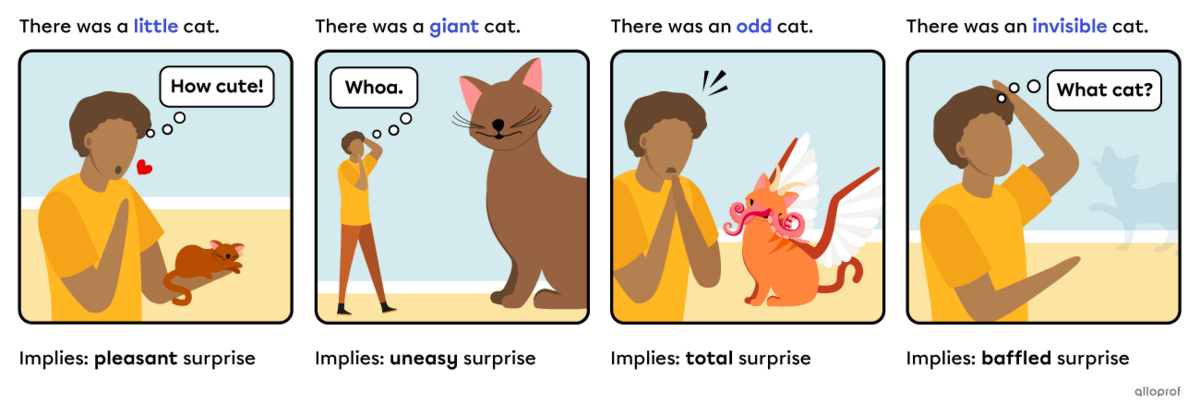
Using a different verb to express the action of the character entering the room.
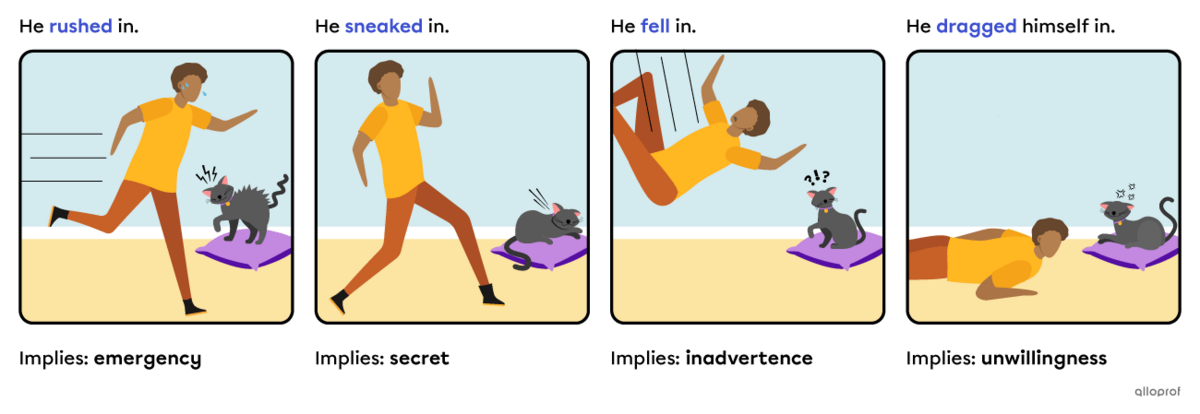
Making connections is relating the text to your own experience, knowledge and ideas.
When to do it
-
While reading the text
-
After reading the text
Reading intention
-
Find deeper meaning
-
Read between the lines
Outcome
-
Better understanding
-
Author's intention
Generally speaking, 3 types of connections are made.
Find the links between the text and yourself by using your:
-
personal experiences
-
feelings
-
opinions
-
ideas
-
beliefs
-
knowledge
Asking yourself questions is a good way to find the links.
|
Question examples |
Follow-up questions |
Works best with |
|
Is the topic familiar to me? |
What do I know about it? |
• informational texts |
|
Have I ever been in a situation like this? |
How similar/different was it? |
• narrative texts |
|
What does this situation/character/event remind me of? |
Why does it remind me of it? |
• informational texts |
|
How interesting is it to me? |
What makes it interesting/not interesting to me? |
• informational texts |
|
What is my opinion or stance on the topic? |
How similar/different is it from the author’s? |
• narrative texts |
Compare similarities and differences between the text and previously read texts.
Looking at general elements common to many texts can provide easy connections.
|
Examples of elements to look for |
Works best with |
|
topic |
• informational texts |
|
themes |
• narrative texts. |
|
purpose |
• informational texts |
|
characters |
• narrative texts |
|
setting |
• narrative texts |
|
events |
• narrative texts |
Find how the text relates to the real world.
Looking beyond a text’s concepts, ideas, events and topics in the grand scheme of things.
|
Real world topics |
Examples of specific real-world elements |
Works best with |
|
Current events |
• news |
most types of texts when adjusted to a given purpose |
|
Historical events |
• historical context |
|
|
Culture & society |
• norms & standards |
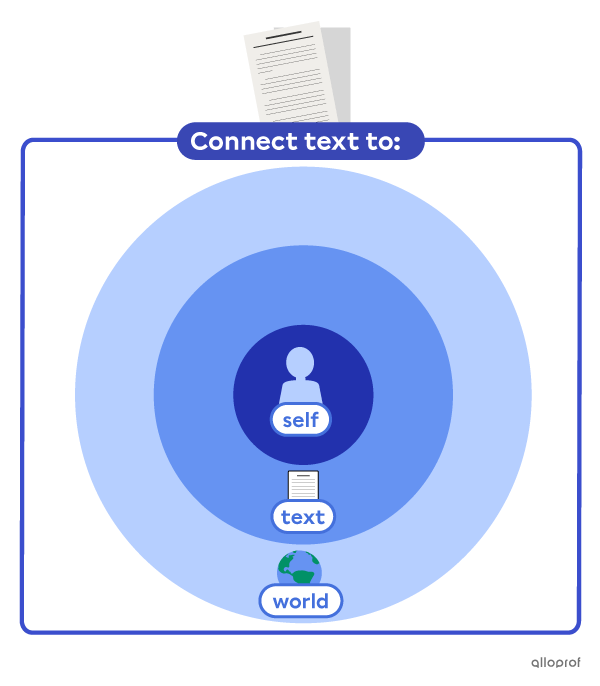
Inferring is reading between the lines.
When to do it
-
While reading the text
-
After reading the text
Reading intention
-
Find deeper meaning
-
Find additional information
-
Draw conclusions
Outcome
-
Better understanding
-
Author's intent & stance
-
Identifying themes
-
Insight into the text’s message
How to Do It
-
Look for clues
-
Connect the dots
-
Draw conclusions
Authors leave clues in their writings, some intentionally and some unintentionally. These clues point to their intent, their message, their stance and even to real world elements around them.
Clues can be found almost anywhere in a text. Here are some examples of text elements that often contain clues.
Looking at the choice of words and the phrasing of a sentence can reveal layers of implied meaning.
|
|
|
|
|
“What a big cat!” thought Jim. |
Word choice: big |
Describes the cat’s size with basic vocabulary |
The cat is a regular cat that is larger than what the character is used to. |
|
Punctuation: exclamation mark |
Expresses surprise |
||
|
“What a huge cat!” thought Jim. |
Word choice: huge |
Describes the cat’s size with richer vocabulary |
The cat is a regular cat, but is much larger than what the character is used to. Possibly one of the largest he has ever seen. |
|
Implies the cat is bigger than just the adjective big |
|||
|
Punctuation: exclamation mark |
Expresses surprise |
||
|
“That’s a really, really big cat,” thought Jim, “Really big.” |
Word choice: really (adverb) + big (adjective) |
Describes the cat’s size |
The size of the cat is unsettling to the character. This is not just a cat. Something else is going on. |
|
Implies the cat is bigger than just the adjective big |
|||
|
Implies the character talking is surprised by the size of the cat |
|||
Paying attention to what characters do and say can point to implied development, story themes, plot points, foreshadowing and so on.
|
|
|
|
|
The cat stretched, jumped down and walked. “Hello, Jim. How do you do,” he then added. |
Greetings |
The cat knows and was expecting Jim. |
This cat is special: it can talk. |
|
Tone |
Friendly |
The cat could be an ally or setting a trap or Jim. |
|
|
The cat stretched, then started licking its paw. “You are late,” he said without looking at Jim, still invested in cleaning its paw. |
Greetings |
The cat was expecting Jim (“you are late”). |
This cat is special: it can talk. |
|
Tone |
Annoyed/impatient |
The cat wants Jim to feel his annoyance/impatience (licking his paw, intentionally not making eye contact) |
|
Looking at how text elements are organized can give insight into the author’s intentions.
|
|
|
|
|
The cat cleared its throat and said: |
Poem → haiku format |
Meaning: expresses that cats are better. |
The character using a haiku poem suggests the character’s knowledge and sophistication, most likely a little superiority complex too. |
|
The cat cleared its throat and recited: |
Informational text → animal classification |
Meaning: provide specific information on the animal classification of the cat. |
The character reciting the animal classification with Latin words suggests encyclopedic knowledge. It is likely the character has a vast array of facts memorized. It is also likely the character likes to show it off. |
Looking at where and when a story takes place will provide extra information and context for the storytelling.
|
|
|
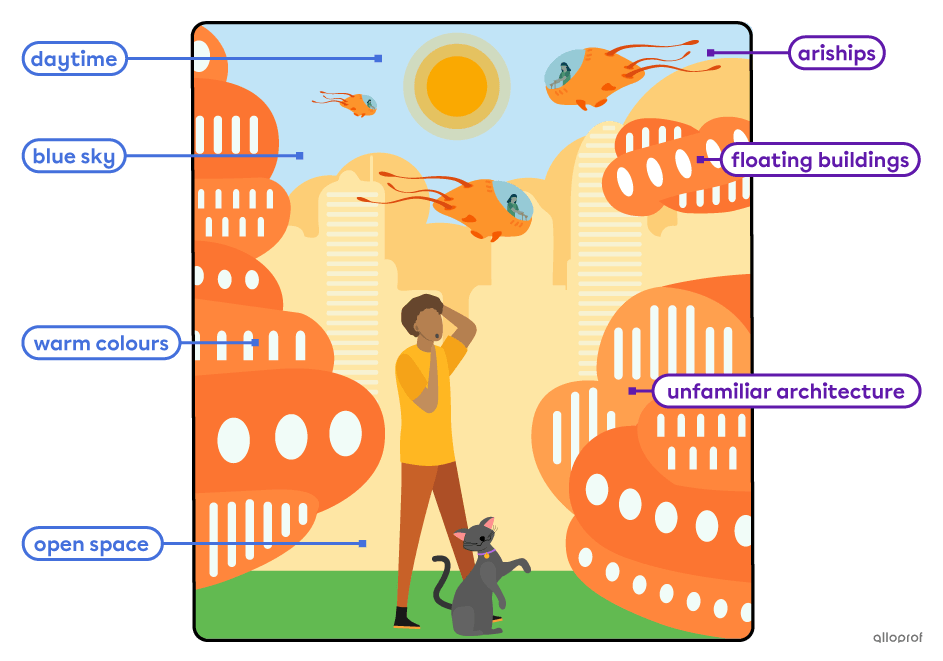
|
Comfortable and welcoming |
|
|
Set in the future |
Unknown technology presented as everyday life is likely to present challenges for the main character. |
|
|
Active and lively |
It could be a used for:
|
|
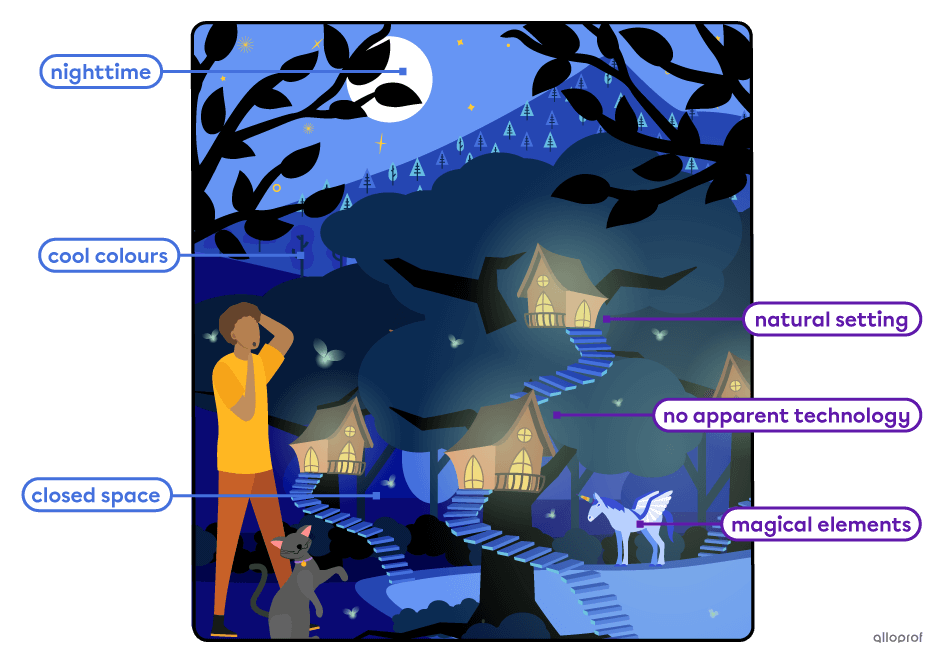
|
Sets a creepy mood |
The author likely wants to destabilize the readers, wanting them to expect something bad to happen. |
|
Looks like a primitive world, maybe set in the past |
The author uses the tropes of the primitive magical world for the reader to quickly understand the surroundings. |
|
|
Magic elements provide a source of power, conflict, technology stand-in |
Annotating is taking notes and writing down comments.
When to do it
-
While reading the text
-
After reading the text
Reading intention
-
Improve understanding
-
Identify specific information
-
Identify meaningful passages
Outcome
-
Deeper understanding
-
Easy access to information when reviewing
-
Better information/content recall
How to Do It
Find and identify relevant information and/or passages.
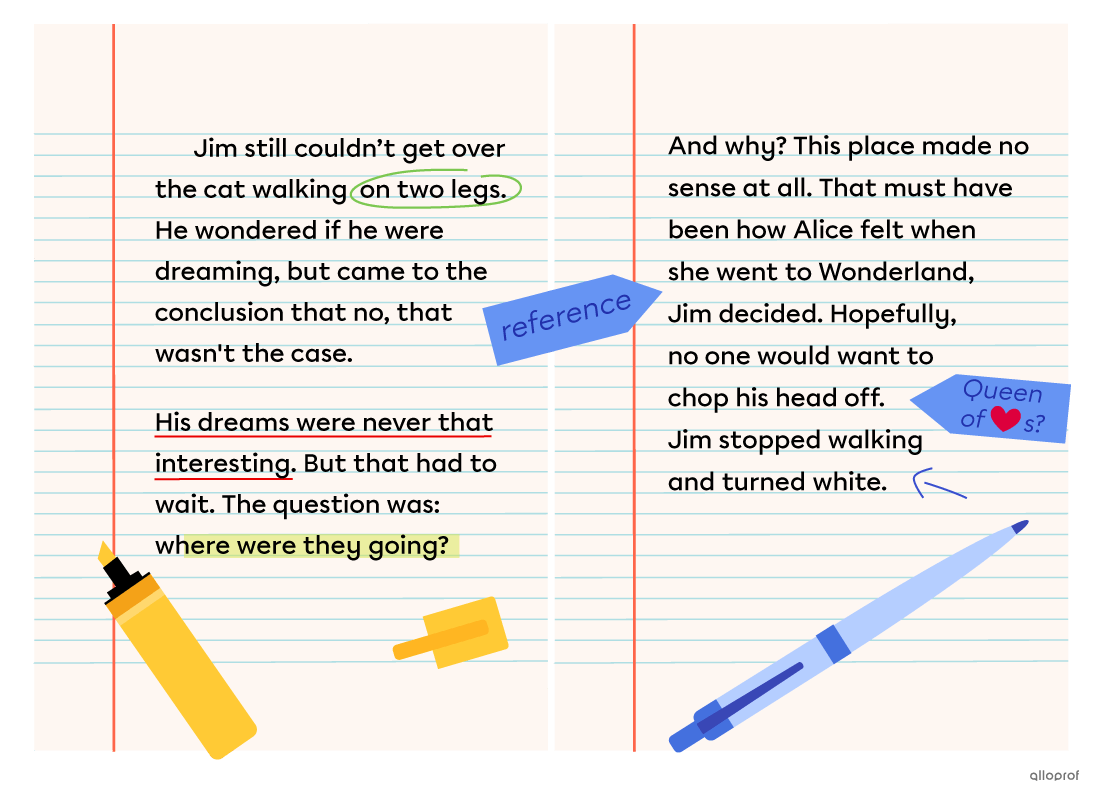
Write down thoughts, summaries, questions, ideas, personal reactions, possible connections and/or predictions.
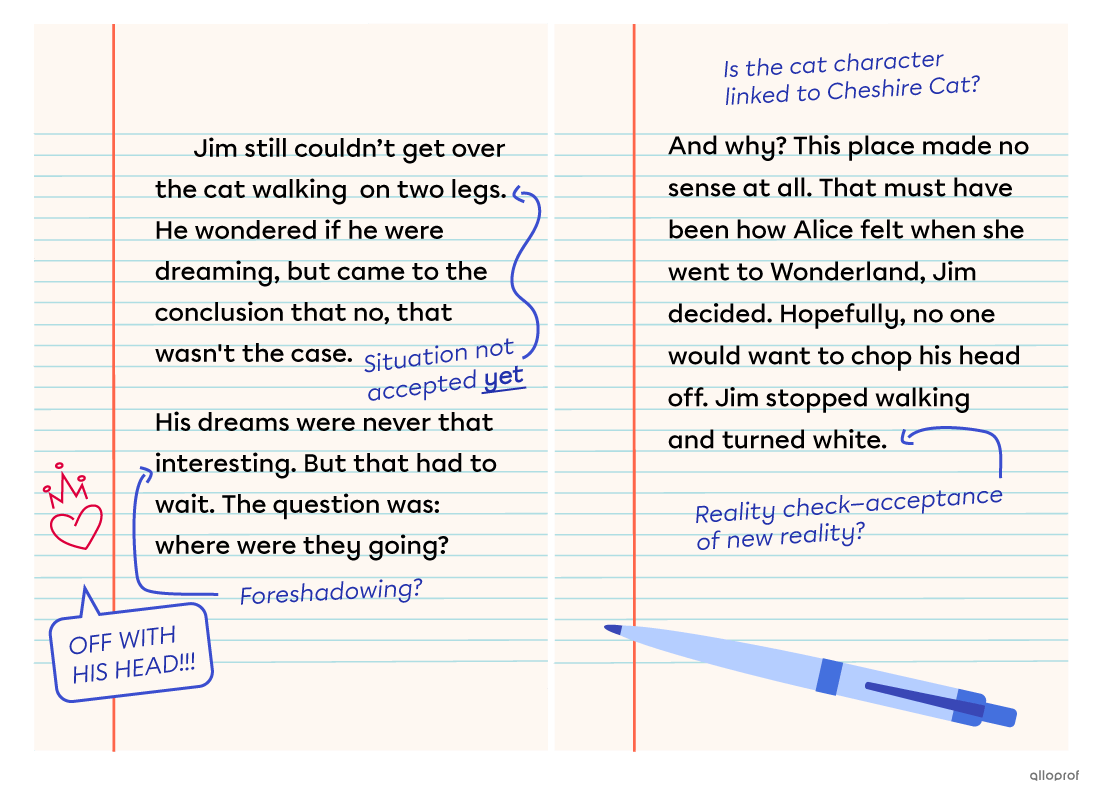
Decoding is finding out the meanings of words.
When to do it
-
While reading the text
Reading intention
-
Understand unknown words
Outcome
-
Better comprehension
-
Increase vocabulary
How to Do It
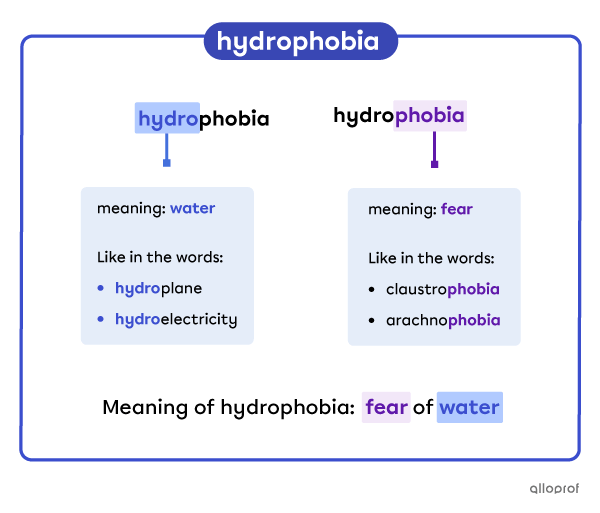
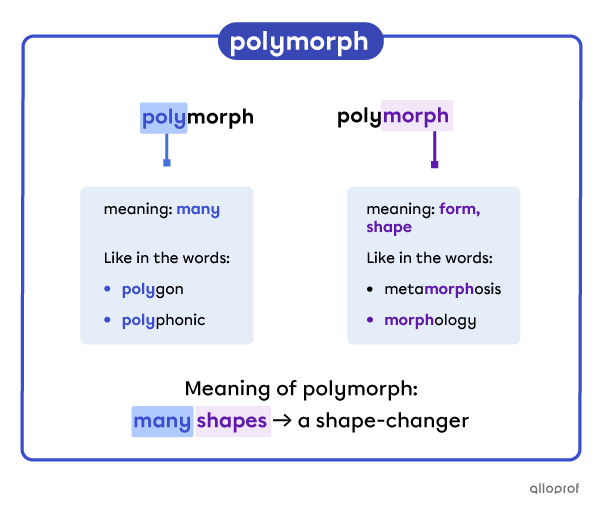
How, where and why a word is used can provide useful clues to its meaning.
Examples of context clues to look for.
Other words around it
Look around for unfamiliar words for:
-
examples relating to it
-
descriptions
-
explanations
Text topic
Think of the general topic of the text. What makes sense?
-
with the themes
-
with the setting
-
with the text type
-
with the author’s intentions
-
with the literary genre
|
The word bipedal in this short passage: |
”Where are we?” asked Jim to the bipedal feline. |
|
Word function |
bipedal is an adjective describing feline. |
|
Other words around it: synonym |
“... a cat walk on two legs?..” |
|
Text topic |
Text type: narrative text |
|
Meaning |
The adjective bipedal describes a cat walking on 2 legs. Plausible in a narrative text in the science fiction or fantasy genre.= |
Summarizing is restating the important points from a text in a shorter, more concise version.
When to do it
-
After reading the text
Reading intention
-
Condense information
-
Organize information
Outcome
-
Makes review easier
-
Gives a good general understanding of the text
How to Do It
-
Look for main ideas
-
List relevant supporting elements
-
Rephrase in your own words
-
Look for Main Ideas
Read the text and ask yourself the question: what is it really about?
Identify the main points or ideas and condense them as a series of short sentences.
-
List Relevant Supporting Elements
Ask yourself if the supporting elements are necessary to convey the main ideas. If you are unsure of the relevance of a text element, note it down for now and discard it if it turns out to be non-essential later on.
-
Rephrase in Your Own Words
Do not quote the text directly: use your own words. Being able to rephrase with your own words means you have understood what you read.
|
Text |
Main ideas |
Relevant supporting elements |
Rephrase |
|
Frankenstein |
|
|
Driven by his obsession with giving life, a scientist manages to create a living being. Disgusted with what he has done, he rejects the monstrosity, pushing the lonely creature to demand the making of a companion. The scientist agrees, but then changes his mind, leading the monster to bring death and destruction to the scientist’s world. Realizing he is responsible for his own troubles, the scientist vows to destroy his creation. |
|
On the Origin of Species by Means of Natural Selection, or the Preservation of Favoured Races in the Struggle for Life |
|
|
The book puts forward the theory of natural selection in the living world. Through observations and use of scientific methodology, Darwin proposes that living things are connected to their environment and other living things. These connections force a competition for survival prompting adaptability and variations in living things. |
Synthesizing is the process of combining ideas from a text with already existing knowledge in order to form a new understanding or perspective.
When to do it
-
After reading the text
Reading intention
-
Make connections
-
Create new meaning
Outcome
-
Provides deeper understanding
-
Improves critical thinking
How to Do It
-
Gather information
-
Look for connections
-
Combine knowledge into new meaning
-
Gather Information
Activate your prior knowledge on the topic and put the information together.
What you know on the topic can come from different sources.
For example:
-
texts (books, articles, studies…)
-
multimedia
-
discussions
-
lectures
-
past experiences
-
Look for Connections
Look for connections between the new information read and what was already known on the topic.
Compare and contrast the information. Ask yourself questions like:
-
How is it similar or different from what I already know?
-
How does it confirm or challenge my understanding?
-
What new information does it add to what I already know?
-
How does it affect my point of view?
-
Combine Knowledge Into New Meaning
Use the previously made connections and the information gathered to develop a fresh perspective on the topic.
Examples of what to look for:
-
a new point of view/opinion
-
a new theory
-
a new narrative
-
a new concept
-
a previously unthought of solution
-
a personal reflection
-
a new creative idea
The synthesizing strategy is a dynamic process, not a checklist of actions to take. Each step taken can influence what the following steps will be and how they could be done or approached
→ Connections made in Step 2 may lead to gathering new information that wasn’t previously relevant, adding to the information gathered in Step 1.
→ Combined knowledge in Step 3 may lead to making new connections, previously not made in Step 2.
The synthesizing strategy should be seen as a tool for a deeper understanding and critical thinking that evolves and adapts as it is being used.
Evaluating is looking at the quality and the credibility of a text.
When to do it
-
While reading the text
-
After reading the text
Reading intention
-
Assess quality
-
Assess credibility
-
Assess purpose and stance
Outcome
-
Better understanding
-
Identifying bias
-
Improved critical thinking
-
Reflection on impact
Never take a text at face value: take the time to question its content. The reason why a text was written can influence the perception of its quality and credibility.
Examples of questions to ask:
|
What is the text’s purpose? |
Is it to entertain? |
What are the themes? Is there an underlying message? Are the characters well defined? Is the plot (or topic) interesting? |
|
Is it to inform? |
Is the information accurate? Can the information be validated? Are there reliable sources? Is it based on evidence? Is the information up-to-date? |
|
|
Is it to persuade? |
What is the stance? Is it objective/biased? Which persuasive techniques are used? Is the reasoning sensible? Are the arguments balanced or one-sided? |
|
|
Who is the intended audience? |
Is it general or targeted? How does the text appeal to its audience? What was the original published format? |
|
|
Does it reach its written purpose? |
Is the written purpose clear? Are all the necessary elements present to reach its written purpose? Could changing text elements make it better? |
Knowing who the author is provides additional information and gives insight into the text meaning. It also provides additional information to evaluate the text’s quality and credibility.
Examples of questions to ask:
|
When was it written? |
What was the social and economic context at that time? |
How have the social and economic context influenced the text? Are the themes or topics related to this context? |
|
What historical events took place around that time? |
Are these events present in the themes or topic of the text? How influential were these events to the text? Are these events represented accurately? |
|
|
How long ago was the text written? |
How does time affect the validity of the information? Is the information still up-to-date or relevant? Are the themes still relatable? |
|
|
Where was it written? |
How does the writing location affect the text? |
Does this location still exist? Are there references to regional features? Is the text in its original language or was it translated? |
|
How was it received at publication? |
What made it a success or a failure? |
How is the text perceived now? How did its success or failure affect the author? |
|
Does its reputation still hold up? |
Is the text now as/less/more relevant? Which elements of the text are still up-to-date? |
The context in which a text was written influences its content.
Examples of questions to ask:
|
When was it written? |
What was the social and economic context at that time? |
How have the social and economic context influenced the text? Are the themes or topics related to this context? |
|
What historical events took place around that time? |
Are these events present in the themes or topic of the text? How influential were these events to the text? Are these events represented accurately? |
|
|
How long ago was the text written? |
How does time affect the validity of the information? Is the information still up-to-date or relevant? Are the themes still relatable? |
|
|
Where was it written? |
How does the writing location affect the text? |
Does this location still exist? Are there references to regional features? Is the text in its original language or was it translated? |
|
How was it received at publication? |
What made it a success or a failure? |
How is the text perceived now? How did its success or failure affect the author? |
|
Does its reputation still hold up? |
Is the text now as/less/more relevant? Which elements of the text are still up-to-date? |
With the answers from the previous steps, evaluate the text’s quality and credibility.
Look at the following questions to help get a general picture of the text.
|
How does the text achieve its written purpose? |
How well is it achieved? What could be done better to achieve it? Why did the text achieve or fail to achieve its written purpose? |
|
How credible is the text? |
How reliable are the information sources? How reliable is the author? How believable is the text? How accurate is it? Is the text well built? |
|
Why would you suggest (or not) this text to others? |
How interesting or entertaining is it? How well written is it? How important or influential is it? How does it appeal to readers? |
Analyzing is looking at how a text is built to assess its quality.
When to do it
-
While reading the text
-
After reading the text
Reading intention
-
Analyze text structure and features
-
Analyze literary techniques & devices
Outcome
-
Provides deeper understanding
-
Improves critical thinking
-
Improves writing skills
The elements used to build a text greatly influence its quality.
Keep in mind that text structures and features are closely related to the text type. Some elements crucial to certain text types can be utterly useless in others.
|
Examples of questions to ask |
Examples of elements to look for |
|
|
How is the text structured? |
|
|
|
Clear beginning, middle and end |
||
|
Are there any specific text-type elements? |
Clear titles and sections Easy to follow organization |
|
|
Plot point leading plot point Character actions and development |
||
|
Clear working hypothesis |
||
|
Which literary techniques and devices are used? |
Figures of speech Plot devices |
|
Find out what the text is really about by reading between the lines and digging into its deeper meaning.
|
Examples of questions to ask |
Examples of elements to look for |
|
|
What is the text about? |
What kind of story is it telling? |
Setting Themes & issues Motifs Symbols Conflicts |
|
What kind of information is it offering? |
Information accuracy Reliable sources Data verifiability |
|
|
What kind of arguments is it making? |
Working hypothesis Clear purpose and stance |
|
An author’s tone, word choices and stylistic decisions greatly affect the meaning of a text.
|
Examples of questions to ask |
Examples of elements to look for |
|
|
What type of language is used? |
Is the tone formal, informal or familiar? |
Idioms Slang expressions Formatting Point of view |
|
What is the writing style? |
Does it follow a specific text type? |
Narrative Text elements Reflective Text elements Explanatory Text elements Report elements Expository/Opinion Piece elements Persuasive Text elements Argumentative Text elements |
|
Does it follow specific formats? |
Plot elements Genre specific elements The plot diagram The hero’s journey Compare and contrast Symbolism Text type format |
|
|
How does the writing style and language affect the text? |
Does it improve it? |
Easy reading flow Appropriate vocabulary Clear structure Engaging reading experience |
|
Does it hinder it? |
Difficult to read Contradicting information or plot points Style over substance |
|
|
What is the author’s voice? |
Is the author’s style recognizable from one work to another? |
Similar theme or topic explorations Similar use of figurative language Recurring tropes Similar use of literary devices Similar character types Similar purpose and/or stance |